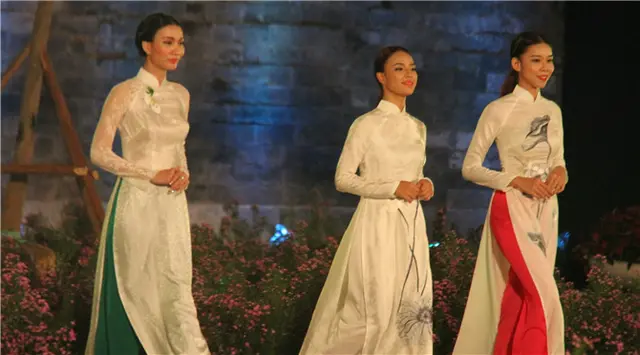In Vietnam's capital city of Hanoi, in the past few days, visitors have had the chance to watch beautiful girls and women dressed in "Ao Dai" during a festival held here to promote the traditional costume.
The three-day festival called "Hanoi Ao Dai Festival 2016," which opened on Friday, is being held under the theme "The Quintessence of Vietnam's Ao Dai."
The event, which aims to promote the traditional garment among the youth, has drawn the participation of 32 designers to showcase their Ao Dai designs in 38 booths.
Thanh Thuy, one of the designers at the festival, told Xinhua that "more and more young Vietnamese females prefer wearing Ao Dai. "
Ao Dai, a tight-fitting silk tunic worn over trousers, is not just the formal costume for festive activities anymore, said Thuy.
Traditionally, Ao Dai was the standard costume for ceremonial occasions such as national holidays, weddings, New Year's Day, graduation day, and also used as uniforms for high school students or for those working for airlines or hotels.
"Modern Ao Dai's are far more functional, which enables women to wear it in their daily lives or even at work," said Thuy, adding that one of her customers wears Ao Dai to go to work almost everyday despite it not being compulsory.
Nguyen Thi Thuy Van, 24, an office worker in Hanoi, told Xinhua that although she loves Ao Dai, she hardly had a chance to wear it in the past, as the costume was always associated with formalities.
"Now, with the emergence of the modernized Ao Dai, I can wear the costume to work, looking graceful and feeling comfortable at the same time," said Van.
Explaining the differences between traditional and modernized Ao Dai, the designer said "The easiest way to distinguish the two kinds is by looking at their lengths. Despite both being very fitted, newer Ao Dai can have modified necklines, sleeves and be knee-length, while traditional ones need to follow stricter rules in terms of neckline, length and sleeves."
As a young fashion designer who wants to develop new looks for the Ao Dai, Thuy said her generation has more kinds of fabric to create traditional and modernized Ao Dai.
"We can renew the image of Ao Dai by using new kinds of patterns, traditional embroidery, ribbon embroidery or by applying heat-printed fabrics," said Thuy.
Speaking to Xinhua while choosing the dress for her own wedding party, Nguyen Thi Hau, 28, said that every different color and design of the garment shows the character of the person wearing it.
For example, students wear simplified white Ao Dai to show their purity, innocence, and young beauty, said Hau, adding that brides prefer to wear a pink or red Ao Dai at her wedding to bring luck and happiness.
Admitting that Vietnam has no worldwide famous Ao Dai brand, Thuy said due to its featured forms, many people thought Ao Dai was solely for Vietnamese people.
However, in the past few years, Ao Dai, which connotes the notion of "cover everything, but hide nothing," has appeared on international fashion catwalks and factories have begun to produce Ao Dais in large numbers.
These Ao Dais are now sold in Vietnam and around the world and the export of the Ao Dai has influenced global clothing designers as far away as Paris, France and New York, Thuy noted.
(APD)
 简体中文
简体中文



